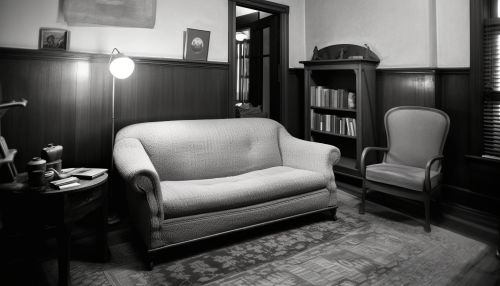Psychoanalysis
Introduction
Psychoanalysis is a set of theories and therapeutic techniques related to the study of the unconscious mind, which together form a method of treatment for mental-health disorders. The discipline was established in the early 1890s by Austrian neurologist Sigmund Freud and stems from his work on hysteria and dream interpretation.


Theoretical Framework
Psychoanalysis is a complex and multifaceted discipline with a theoretical framework that is constantly evolving. At its core, it is a dynamic theory of the mind, which emphasizes the importance of unconscious mental processes and the influence of early childhood experiences on later personality development and mental health.
Topographical Model
Freud's initial theoretical construct, known as the topographical model, describes the mind as divided into three regions: the conscious, the preconscious, and the unconscious. The conscious mind includes everything we are aware of, while the preconscious consists of thoughts and feelings that we can potentially bring into consciousness. The unconscious mind, however, contains thoughts, memories, and desires that are well below the surface of conscious awareness, but that nonetheless exert a powerful influence over behavior.
Structural Model
Later, Freud proposed a structural model of the mind, composed of the id, ego, and superego. The id is the source of our bodily needs, wants, desires, and impulses, particularly our sexual and aggressive drives. The ego is the component of personality, charged with dealing with reality, while the superego is the moral component of personality, which incorporates the values and morals of society.
Techniques
Psychoanalytic treatment primarily focuses on the relationship between the analyst and the patient, a social construct that differs from the medical patient-doctor relationship. The analyst uses various techniques as his or her tools for the work of analysis.
Free Association
One of the fundamental techniques of psychoanalysis is free association, in which patients are invited to relate whatever comes into their minds during the analytic session, and to not censor their thoughts. This technique is intended to help the patient learn more about what he or she thinks and feels, in an atmosphere of non-judgmental curiosity and acceptance.
Dream Analysis
Another important psychoanalytic technique is dream analysis, in which dreams are treated as metaphors that contain important information about unconscious desires, thoughts and conflicts. Psychoanalysts use a variety of techniques to decode the metaphor that is presented in the dream, and to "translate" it into words that the patient can understand.
Transference and Countertransference
Transference is a phenomenon where the patient redirects feelings and fantasies from their past onto the therapist. It is seen as a process that happens in degrees, and to all people in their everyday lives. Countertransference is defined as redirection of a psychotherapist's feelings toward a client—or, more generally, as a therapist's emotional entanglement with a client.
Criticisms and Controversies
Like any scientific discipline, psychoanalysis has been subject to criticism and controversy throughout its history. Some critics argue that psychoanalysis lacks a sound scientific basis, while others claim that its theories are outdated and patriarchal. Despite these criticisms, psychoanalysis continues to be a highly influential school of thought in the fields of psychology and psychiatry.
Influence and Applications
Psychoanalysis has had a profound influence on many aspects of 20th and 21st century culture, particularly in the fields of film, literature, and art. It has also been applied in the field of education, with a focus on understanding the developmental processes of children.
